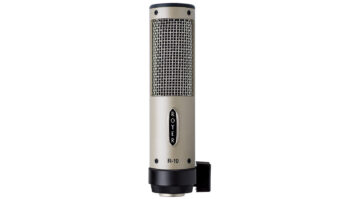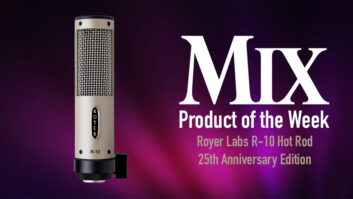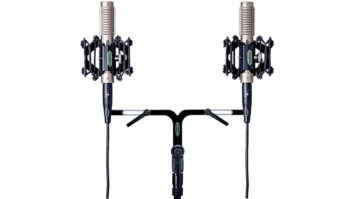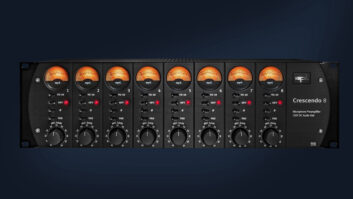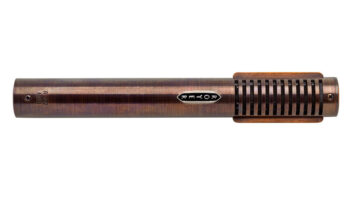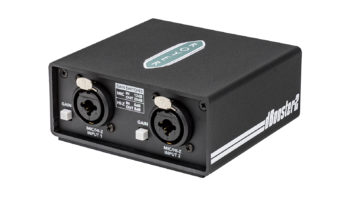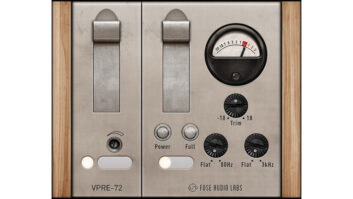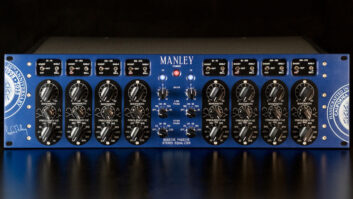Ribbon mics, by nature, exhibit a warm and
friendly tone with a natural figure-8 pattern that’s useful in a
variety of studio applications. However, ribbon microphone fans-and
many respected engineers swear by these mics for particular
applications-have few choices. There are the vintage models, which
include very old and fragile mics like the RCA 77, 44 and BK11 models,
and Bang & Olufsen ribbons, none of which are manufactured anymore.
And there are a few currently produced ribbons, including the Coles
4038 and 4104B models, the Beyer M500 handheld mic and AEA’s R44c, a
replica of the RCA 44.
It is therefore a cause for celebration that another manufacturer
has stepped forward with a ribbon design-this one taking advantage of
recent developments in magnet design, materials and mechanical
construction. The new Royer R-121 Ribbon-Velocity studio microphone
uses a pure aluminum ribbon measuring 31/416-inches wide by 1.75 inches
long and just 2.5 microns thick. This ribbon element is suspended
between two powerful neodymium magnets in a specially designed
flux-frame assembly. The magnets protrude like a pair of “ears” through
machined slots on either side of the mic’s body. (Be careful about
placing the microphone near ferrous metal particles and dust as they
will stick to these magnet ears.)
The microphone body, a burnished nickel-finished steel tube (black
matte chrome also available) measuring 6.13 inches long by 1 inch in
diameter, is an integral design feature and is said to reduce the
audible effect of cavity resonance. A built-in, two-stage, stainless
steel screen arrangement provides acoustical damping for the ribbon as
well as wind blast protection. The screen also prevents the internal
magnet assembly from collecting metal particles.
I have found that older ribbon mics are sometimes big, heavy and
obtrusive, which can make them difficult to position and work with in
the studio. By contrast, the Royer’s small size and weight (only 8.6
oz.) make it as easy to use as any dynamic or condenser mic. The Royer is a “side address” mic,
with a fixed figure-8 polar pattern. I found that the mic sounded the
same and was equally sensitive on either side. Maximum SPL is rated at
130 dB, and I tested this specification often.
Frequency range is rated at 30 to 15k Hz with sensitivity at -53 dBv Ref. 1 volt +/-1dB-that’s more output than a
Shure SM57 dynamic or the old RCA 44 ribbon. Self-noise (not printed on the spec sheet)
is very low, as expected; there are no internal preamp electronics, and
phantom powering is not required. (In fact,
phantom power should be turned off, as a faulty cable could damage the
ribbon). Rated load impedance is 1,500 ohms.
I had the opportunity to use two Royers during tracking sessions for
a rock album. I would classify the microphone as a musical instrument
mic since it may not be the first choice as a general-purpose vocal
mic. I used the mic on electric guitars with great success-it gave me a
warmer and fatter sound than my favorite dynamic. I like to mix
microphones when recording guitars, and the Royer’s sound is
unmistakable whether mixed with another microphone or on its own.
The mic’s sound didn’t seem to change during many hours of abuse
from two Marshall cabinets. I used one of the R-121s close to the
speaker and another placed farther away as an overall cabinet mic. Due
to the proximity effect, a dynamic or condenser mic on
the cabinet would sound thinner than the same mic up close, but this
was not the case with the Royer. The figure-8 pattern is noticeable
with either mic placement, and there is room for some interesting
experimentation here. I try putting the “null” (the side of the mic) of
the pattern toward the amp cabinet. If you “null out” the close mic,
you’ll get a close sound with extra room ambience…a little hard to
describe. If you null out the farther-away cabinet mic, the effect is
similar to an even farther-away room mic (or the illusion of a bigger
recording space). I also put one Royer equidistant between two Marshall
cabinets facing each other. I flipped the phase of one cabinet (speaker
cable) so the two cabinets were “pushing and pulling.” I got a very fat
guitar sound that pumped a lot of air and I lived to tell about it!
Next, I tried both Royers on grand piano. Since I wanted a close,
pop piano sound, I put the mics over the hammers, one at the low end
and one at the high end. I didn’t have any phase problems as I thought
I might have with two figure-8 mics. Mono compatibility (does anyone
care these days?) was about as good as any wide-spaced pair of cardioid mics. I did get extra ambience and a
little bounce off the piano’s fully opened lid. All of these features
led to a good, full piano sound that was not too bright, the right size
to fit within the track-all without any furious EQ twiddling.
Using two Royers as drum overheads provided a warmer sound than I am
used to but worked fine for the softer ballad I was recording. However,
for that popular overbright sound du jour drum overhead sound, I would
probably go with my Milabs. (A condenser mic is probably an unfair
comparison.)
Royer also makes the Royer/Speiden SF-12 stereo coincident ribbon
microphone. The Speiden design consists of a dual capsule,
stereo-crossed figure-8 with two ribbons, one on top of the other,
positioned at 90 degrees to one another-the center axis is at the
45-degree point between the two ribbons’ center axes. With a 2-micron
ribbon weighing about 0.3 milligrams, this mic is said to exhibit
excellent transient response. This is the only Blumlein pair of ribbon
mics currently made and is designed for orchestral, choir recording or
any other distance-miking application. The Royer R-121 sells for $995
retail while the SF-12 Royer/Speiden microphone sells for $1,995.
Royer Labs, www.royerlabs.com
